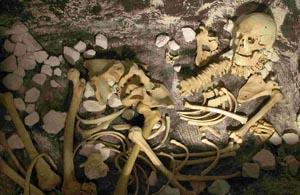 Submitted by ZERO POINT - Ex... on
Submitted by ZERO POINT - Ex... on
Secrets Of The Stonehenge Skeletons - 2013 Documentary, current theories on bone fragments found at stonehenge.
New findings at Stonehenge by an AHRC-funded collaborative research team led by Professor Mike Parker Pearson have been revealed in a special Channel 4 documentary and are attracting media attention.
British archaeologists led by Professor Mike Parker Pearson are rewriting the story of Stonehenge. The team analysed the ancient remains of 63 bodies buried around Stonehenge, finding that the first monument was originally a graveyard for a community of elite families, whose remains were brought to Stonehenge and buried over a period of more than 200 years. The new discovery has finally solved many of the mysteries surrounding Stonehenge, overturning the accepted view on construction and use of our greatest prehistoric monument.
Professor Parker Pearson comments: “The first Stonehenge began its life as a huge graveyard....the original monument was a large circular enclosure built 500 years before the Stonehenge we know today, with the remains of many of the cremated bodies originally marked by the bluestones of Stonehenge. We have also discovered that the second Stonehenge was built 200 years earlier than thought, around 2500 BC.”
http://www.ahrc.ac.uk/News-and-Events/News/Pages/Secrets-of-the-Stonehenge-Skeletons.aspx

By testing cattle teeth from 80,000 animal bones excavated from the Stonehenge complex, the team also found that around 2500 BC it was once the site of vast communal feasts attended by perhaps up to a tenth of the British population, with people coming from as far afield as highland Scotland to celebrate the solstice.
These new findings were revealed for the first time in a The Secrets of the Stonehenge Skeletons, Oxford Scientific Films/Terra Mater Factual Studios co-production for Channel 4, which indicated that animals were slaughtered in the Winter, nine months after their spring birth, pointing to the Mid-Winter Solstice gatherings at Stonehenge being a time for feasting on an unprecedented scale.
“Stonehenge was a monument that brought ancient Britain together. What we’ve found is that people came with their animals to feast at Stonehenge from all corners of Britain - as far afield as Scotland. Stonehenge was built soon after the appearance of the first pan-British culture, the only time in prehistory that the people of Britain were unified.” Said Professor Parker Pearson
Once completed, Stonehenge declined after two centuries. For years, this decline has been a mystery. But Mike believes that it is explained by the culture of the ‘Beaker People’, known to have arrived in these isles around this time. He feels that their greater individualism and new material goods, including the first metal goods seen in Britain, put an end to the communal culture for which the monument had originally been created. Beakers were placed in graves of the continent-derived Beaker burial rite; this beaker is from Netheravon Flying School in Wiltshire.
According to Professor Parker Pearson: “In many ways our findings are rewriting the established story of Stonehenge. “What we’ve uncovered is compelling evidence that Stonehenge once united the people of Britain, attracting people from far and wide for Solstice gatherings, but also that the bodies and grave goods found on and around the site also offer an answer to the mystery of Stonehenge’s decline.”
- 2954 reads